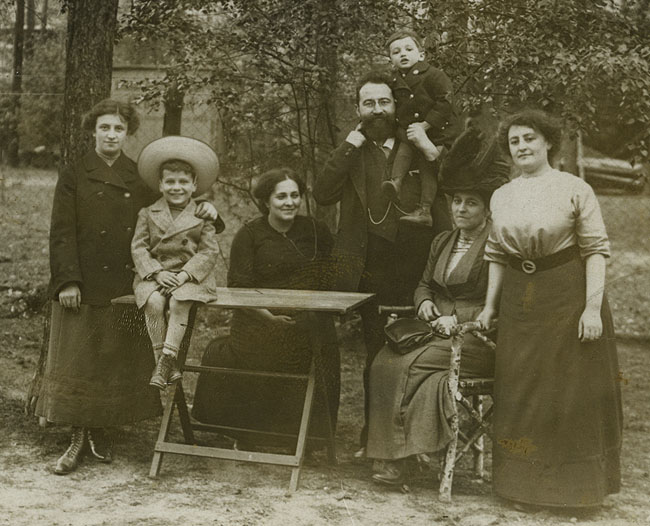Rosa Graetzer Freudenthal, 1870–1951, proprietor of the Kunstgewerbestube Freudenthal, Breslau.

Well into middle age—she was about 50—Rosa Freudenthal, widow of physician Samuel Freudenthal and mother of two grown sons, launched an art gallery from her home. The grisly post-war economic circumstances suggest that she needed the money.1More than Child’s Play: Rosa Freudenthal’s Arts and Crafts Workshop, “The Woman Behind the Workshop.” Israel Museum. Retrieved July 16, 2025 from https://www.imj.org.il/en/content/more-child%E2%80%99s-play-0. Her evident enthusiastic engagement and ingenuity, however, go far above and beyond any purely financial necessity.
At first, the undertaking featured works by Freudenthal’s late brother Alfred Graetzer, an artist (and friend of Hermann Struck), who had just begun to achieve success when he died of tuberculosis in 1911. She placed classified ads in community newspapers in December of 1920 announcing a two-week Hanukkah exhibition that also showed contemporary Jewish graphics and crafts. Four months later, works by metalsmiths Leo Horovitz (Frankfurt), Georg Mendelssohn (Hellerau), Friedrich Alder (Hamburg) and Jaroslav Vonka, professor at the Arts and Crafts School in Breslau, headlined her new show, with textiles by Rosa Weyl (Breslau) and Hilde Zadikov (Munich) and an exceedingly charming paper sukkah by Erna Selten (Breslau) in supporting roles. Freudenthal astutely juxtaposed modern household objects available at affordable prices with historical treasures, many briefly on loan from the collection of Sally Kirschstein (Berlin-Nikolassee), even then unofficially considered the Jewish Museum of Berlin.2Pelc, Ortwin, „Jüdische Museen in Deutschland,” Jüdisches Leben in Erinnerung und Gegenwart: Archive, Bibliotheken, Museen, Gedenk- und Forschungsstätten im deutschsprachigen Raum. Schriften der Kommission für die Geschichte der Juden in Hessen; Band 33. Karin Bürger and Ortwin Pelc, editors. Göttingen, Wallstein, 2023. p 15.
In newspaper advertisements for her December exhibition later in 1921, Freudenthal gave her enterprise a new name (and perhaps coined a new word): Kunstgewerbestube Freudenthal, parlor or salon of applied arts. The name was appropriate. She had transformed her own “small, tastefully appointed living room, the walls of which were graced with prints by [Siegfried] Laboschin, into an elegant museum. [It is] a splendid tableau and, in its entirety as in every detail, a testament to the vibrant, warm and devout spirit that brings it all to life.”3“So bot der in ein kleines, stilvolles Museum umgewandelte Raum, dessen Wände Bilder von Laboschin schmückten, ein prachtvolles Bild und bezeugte in einer Gesamtheit wie in jeder Einzelheit den lebendigen warmen religiösen Geist, der alles belebt.”
E.D., “Ausstellung jüdischer Kultusgegenstände,” Jüdisch-liberal Zeitung, April 22, 1921. But she did not restrict herself to exhibitions in her apartment in Breslau. As early as 1923, she displayed her wares in Frankfurt, Berlin, Karlsruhe and other cities. In 1925, she presented at the 14th Zionist Convention, where her ceremonial objects and crafts received a positive response: “At first glance, they looked like work from the Bezalel School, but then astoundingly, the observer discovered they were good Jewish crafts from Germany, and what’s more, from Breslau.”4“Viel Beachtung fanden die künstlerischen Kultusgeräte und Kultushandarbeiten der Kunstgewerbestube Freudenthal. Man hielt die Arbeiten zunächst für &slquo;Bezalel&srquo; und war dann erstaunt, gutes jüdisches Kunstgewerbe aus Deutschland und noch dazu aus Breslau vorzufinden.”
“Kunst und Kunstgewerbe beim 14. Zionisten-Kongreß,” Die Wahrheit, September 18, 1925, p. 24.
Special acclaim went to the quality of her artful, educational and entertaining toys which included dreidels, a Hebrew language-based lotto game that inspired many imitators, a mini-printshop, holiday pennants and Wunschbögen, a kind of greeting card for children to write their good wishes for the new year to parents and grandparents.
“If we want the adult to love and value their Jewish heritage, then we should have the child play Jewish games. The Kunstgewerbestube Freudenthal shows us how that can happen. This series of work engenders so much joy as soon as you see it, that you are tempted to play with your kids for many hours.”5“Wollen wir, daß den erwachsenen Menschen ihr Judentum lieb und wert ist, so sollen wir auch schon die Kinder jüdisch spielen lassen. Wie das geschehen kann, zeigt uns die Kunstgewerbestube Freudenthal in einer Reihe von Arbeiten, die beim Betrachten schon solche Freude machen, daß man versucht ist, viele Stunden mit den Kindern zu spielen.”
Cohn, Willy, “Jüdisches Spielzeug,” Menorah, September 1927, p 562.
Freudenthal aimed at more than the German market and in 1932, brought out a card game called “The Proverbs of Solomon” in Hebrew, German and English. She pressed on in Germany until 1934, when she joined her son Erich and his family in Haifa. (Her son Walter, a physician like his father, had gone to London the year before.) Although she made some attempts to continue in business in her new surroundings, the Kunstgewerbestube Freudenthal effectively came to an end.6Ibid. More than Child’s Play: Rosa Freudenthal’s Arts and Crafts Workshop.
Rosa Freudenthal was the sister of Ismar David’s aunt Elise, wife of his mother’s brother, Ismar Freund. Rosa Freudenthal’s nephew Heinz, son of her late husband’s brother Siegfried, owned Graphos Stationery in Jerusalem. In 1930, Ismar David made the drawing for one of the Kunstgewerbestube’s Wunschbögen. A reviewer described it like this: “The child is familiar, from school and from temple, with the words at the top of the card: תקעו בחדש שופר. A dignified old man blows the shofar. He is not dressed in a tuxedo and top hat, as we so often see nowadays, but instead he wears his kittel, reminding us to look deep within ourselves.”7“תקעו בחדש שופר steht am Kopf des Bogens, die Worte, die das Kind aus der Schule und der Synagoge kennt. Der Schofar-bläser ist ein würdiger alter Mann, nicht wie er jetzt so häufig zu sehen ist, im Smoking und Zylinder, sondern in den Sterbe-kleidern, zu innere Einkehr gemahnend.”
M., “Notizen,” Jüdische Schulzeitung: Monatschrift für Pädagogik und Schulpolitik, September 15, 1930, Hamburg, p.8.
Two copies of this Wunschbogen at the Israel Museum shows David thanking his aunt’s sister for her valuable help, but nonetheless disregarding the criticism she has written on the proof.
Many thanks to curator Alona Farber and her excellent exhibition, More Than Child’s Play, The Israel Museum, Jerusalem 2024, for uncovering Rosa Freudenthal’s pioneering enterprise in Breslau and its connection to Ismar David and his early work.

























